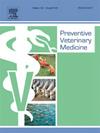A nutritional prognostic model for hospitalized Belgian blue calves: The Calf-CONUT ratio for predicting survival
IF 2.2
2区 农林科学
Q1 VETERINARY SCIENCES
引用次数: 0
Abstract
Malnutrition is a major factor in disease management failure. In humans, the CONUT (COntrolling NUTritional status) score assesses nutritional status based on albumin, cholesterol, and lymphocyte levels (sensitivity 92,30 %; specificity of 85 %). In bovine medicine, few studies focus on calf nutrition status. This study compares serum urea, cholesterol, and albumin levels in Belgian Blue calves between hospital admission and discharge (or death) and between survivors (S) and non-survivors (NS). At admission, cholesterol levels did not significantly differ between groups (p > 0.1). Albumin levels were higher in S (p = 0.02), while urea levels were lower (p = 0.04). At discharge, S showed a significant increase in cholesterol (p < 0.05) and a decrease in urea (p < 0.01) and albumin (p < 0.05). A urea/albumin ratio, named the Calf-CONUT ratio, above 2.64 was associated with increased mortality risk (Relative Risk: 2.29, Odds Ratio: 5.75) but demonstrated low sensitivity (46 %) and high specificity (87 %), suggesting limited standalone predictive power. If the analysis focuses solely on calves suffering from enteritis, the threshold value is 2.85, with improved sensitivity and specificity (Se 83 %; Sp 78 %; relative risk: 10; odd ratio: 15). This study provides initial insights into the nutritional assessment of hospitalized calves and paves the way for innovative approaches to their nutritional and medical management. Further research on specific diseases and breeds is needed to refine these thresholds.
住院比利时蓝犊的营养预后模型:小牛- conut比率预测生存
营养不良是疾病管理失败的一个主要因素。在人类中,CONUT(控制营养状况)评分基于白蛋白、胆固醇和淋巴细胞水平评估营养状况(敏感性92,30 %;特异性为85 %)。在牛医学中,很少有研究关注小牛的营养状况。本研究比较了比利时蓝犊入院和出院(或死亡)以及幸存者和非幸存者(NS)之间的血清尿素、胆固醇和白蛋白水平。入院时,两组之间的胆固醇水平无显著差异(p >; 0.1)。S的白蛋白水平较高(p = 0.02),而尿素水平较低(p = 0.04)。出院时,S的胆固醇显著升高(p <; 0.05),尿素显著降低(p <; 0.01),白蛋白显著降低(p <; 0.05)。尿素/白蛋白比率,称为Calf-CONUT比率,高于2.64与死亡风险增加相关(相对风险:2.29,优势比:5.75),但表现出低敏感性(46 %)和高特异性(87 %),表明独立预测能力有限。如果只分析患有肠炎的小牛,阈值为2.85,灵敏度和特异性均有所提高(Se 83 %;Sp 78 %;相对风险:10;奇数比:15)。这项研究为住院小牛的营养评估提供了初步的见解,并为其营养和医疗管理的创新方法铺平了道路。需要对特定疾病和品种进行进一步研究,以完善这些阈值。
本文章由计算机程序翻译,如有差异,请以英文原文为准。
求助全文
约1分钟内获得全文
求助全文
来源期刊

Preventive veterinary medicine
农林科学-兽医学
CiteScore
5.60
自引率
7.70%
发文量
184
审稿时长
3 months
期刊介绍:
Preventive Veterinary Medicine is one of the leading international resources for scientific reports on animal health programs and preventive veterinary medicine. The journal follows the guidelines for standardizing and strengthening the reporting of biomedical research which are available from the CONSORT, MOOSE, PRISMA, REFLECT, STARD, and STROBE statements. The journal focuses on:
Epidemiology of health events relevant to domestic and wild animals;
Economic impacts of epidemic and endemic animal and zoonotic diseases;
Latest methods and approaches in veterinary epidemiology;
Disease and infection control or eradication measures;
The "One Health" concept and the relationships between veterinary medicine, human health, animal-production systems, and the environment;
Development of new techniques in surveillance systems and diagnosis;
Evaluation and control of diseases in animal populations.
 求助内容:
求助内容: 应助结果提醒方式:
应助结果提醒方式:


